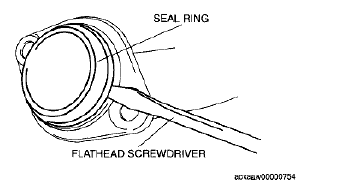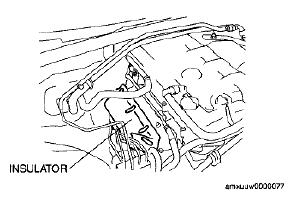Chevrolet Trax: Rear rail sectioning
Chevrolet Trax (2013-2022) Workshop Manual / Accessories & Equipment / Collision Repair / Collision repair - Repair instructions / Rear rail sectioning
Removal Procedure
WARNING: Refer to Approved Equipment for Collision Repair Warning .
WARNING: Refer to Collision Sectioning Warning
WARNING: Refer to Glass and Sheet Metal Handling Warning .
- Disable the SIR system. Refer to SIR Disabling and Enabling .
- Disconnect the negative battery cable. Refer to Battery Negative Cable Disconnection and Connection .
- Remove all related panels and components.
- Visually inspect the damage. Repair as much of the damage as possible.
- Remove the sealers and anti-corrosion materials from the repair area, as necessary. Refer to Anti- Corrosion Treatment and Repair (Base) .

Fig. 133: Mark On Outer And Inner Lower Surface Of Rear Rail
- Locate the die mark on the outer and inner lower surface of the rear rail.
NOTE: Do not section the rail in any area other than the die mark location given.
- Align a sliding square or similar tool to the line at the tip of the arrow in the die mark. Scribe a line across the rail.

Fig. 134: Cutting Panel
NOTE: Do not damage any other panels or reinforcements.
- Cut the panel where sectioning is to be performed (1).
- Locate and mark all the necessary factory welds of the rear side rail.
.gif)
Fig. 135: Drilling Factory Welds
- Drill all factory welds (1). Note the number and location of welds for installation of the service assembly
.gif)
Fig. 136: Rear Side Rail
- Remove the damaged rear side rail (1).
.gif)
Fig. 137: Drilling Plug Weld Holes In Rear Side Rail
- Drill two 8 mm (5/16 in) plug weld holes on each of the 3 sides of the rear rail (1). Position the center of the holes 10 mm (3/8 in) from the cut edge.
Installation Procedure
- Locate the original cutting line on the service part rear rail.
- Align a sliding square or similar tool to the original cutting line and scribe a line across the rail.
- Use the same tool to transfer this scribed line onto the sides and the weld flanges of the rail.
- Place a mark forward, 25 mm (1 in) from the scribed line on all 3 sides of the service rail.
- Use the tool to scribe a line on all 3 sides and weld flanges of the rail.
.gif)
Fig. 138: Rear Portion Of Rail
- Cut at the scribe line (1).
- Remove the rear portion of the rail.
.gif)
Fig. 139: Rear Side Rail Outer Flanges
- Cut the upper outer flanges of the rear portion of the rear rail service part. Cut the flanges back to the first scribe line and remove the tabs.
- Cut the lower radius corners of the service part back to the first scribe line and remove the small corners.
- Bend the bottom side of the service part at the sectioning location inward slightly by aligning a vice grip flanging tool or similar tool at the first scribed line.
- Clean and prepare the attaching surfaces for welding.
.gif)
Fig. 140: Rear Side Rail
- Position the rear side rail (1) on the vehicle.
.gif)
Fig. 141: Tack Welding Rear Side Rail
- Tack weld the part into position.
- Inspect the service rear rail for proper dimensions, using 3-dimensional measuring equipment.
- Plug weld at each 8 mm (5/16 in) plug weld hole location.
- Stitch weld along the entire sectioning joint. Make welds along the seam with 25 mm (1 in) gaps between. Weld the gaps.
- Clean and prepare the welded surfaces.
- Apply the sealers and anti-corrosion materials to the repair area, as necessary. Refer to Anti-Corrosion Treatment and Repair (Base) .
- Paint the repaired area. Refer to Basecoat/Clearcoat Paint Systems .
- Install all related panels and components.
- Connect the negative battery cable. Refer to Battery Negative Cable Disconnection and Connection .
- Enable the SIR system. Refer to SIR Disabling and Enabling .
READ NEXT:
 Rear end panel replacement
Rear end panel replacement
Removal Procedure
WARNING: Refer to Approved Equipment for Collision Repair Warning .
WARNING: Refer to Glass and Sheet Metal Handling Warning
NOTE: The rear end lower panel reinforcement extension is
 Body tail lamp filler panel replacement
Body tail lamp filler panel replacement
Removal Procedure
WARNING: Refer to Approved Equipment for Collision Repair Warning .
WARNING: Refer to Glass and Sheet Metal Handling Warning
Disable the SIR System. Refer to SIR Disabling and Enab
SEE MORE:
 Object alarm module programming and setup
Object alarm module programming and setup
NOTE:
DO NOT program a control module unless directed to by a service
procedure or a service bulletin. If the control module is not properly
configured with the correct calibration software, the control module will
not control all of the vehicle features properly.
Ensure the programming tool i
 Brake warning indicator malfunction (WITHOUT J41)
Brake warning indicator malfunction (WITHOUT J41)
Diagnostic Instructions
Perform the Diagnostic System Check - Vehicle prior to using this
diagnostic procedure.
Review Strategy Based Diagnosis for an overview of the diagnostic
approach.
Diagnostic Procedure Instructions provides an overview of each
diagnostic category.
Diagnostic Fault
© 2019-2025 Copyright www.chevtrax.com

